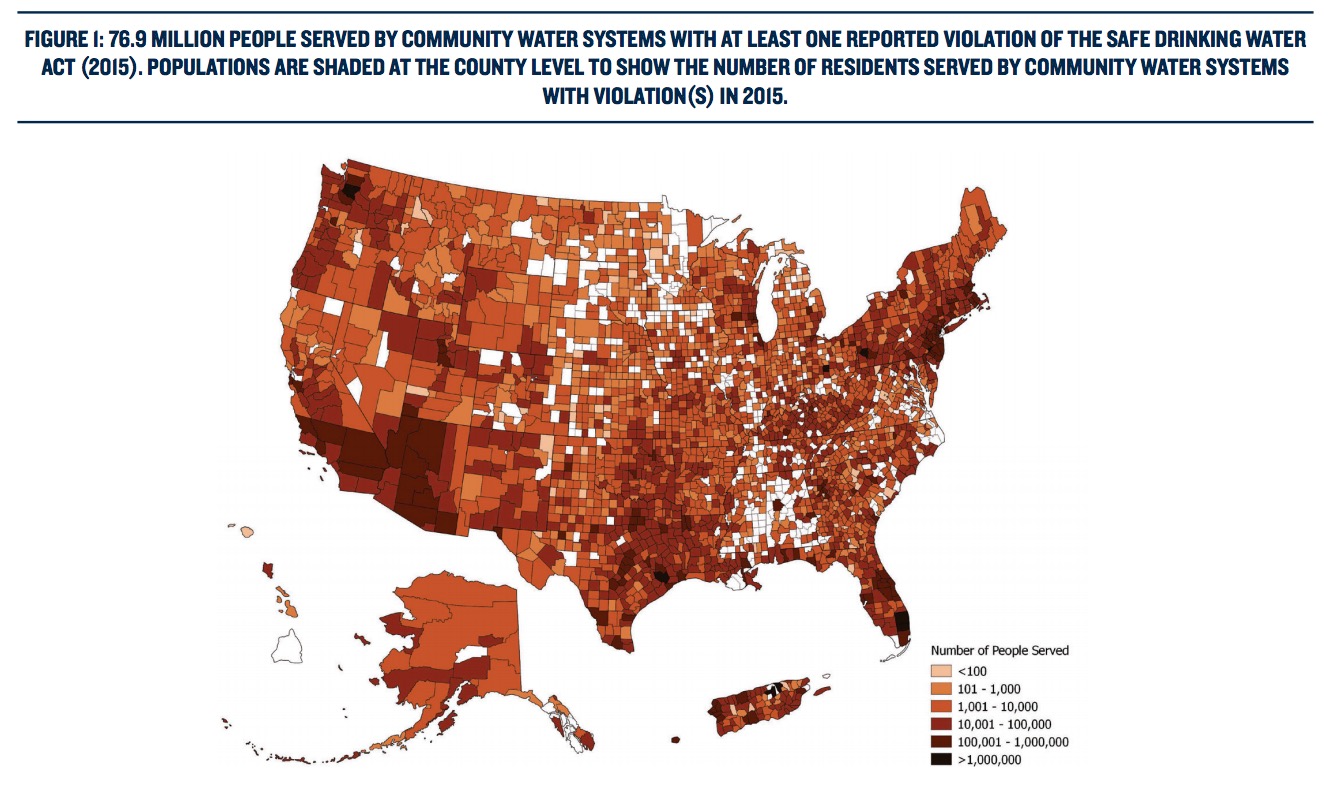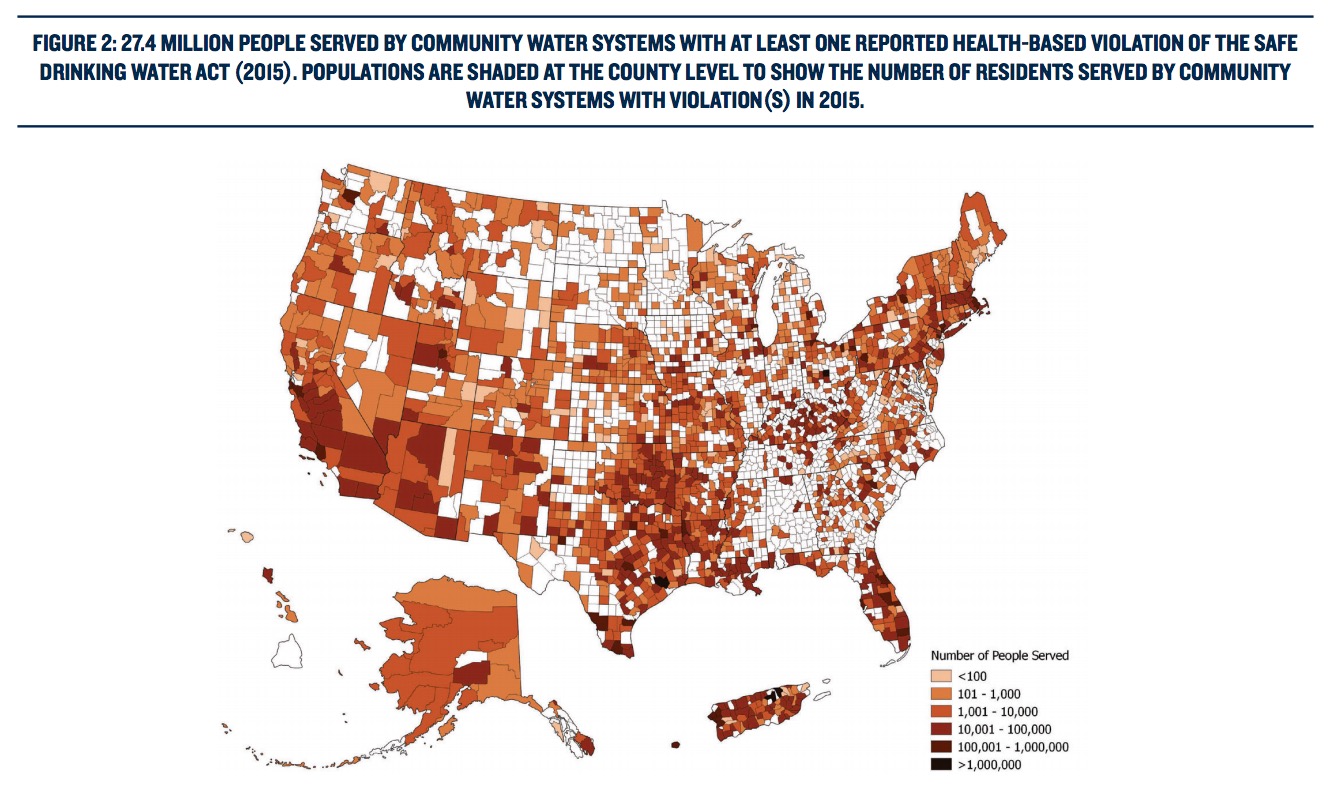NATURAL RESOURCES DEFENSE COUNCIL (NRDC)
Executive Summary
The Safe Drinking Water Act (SDWA), one of our bedrock environmental laws, established the role of government in providing safe, clean drinking water. Instituted in 1974, the SDWA requires the U.S. Environmental Protection Agency (EPA) to identify and regulate contaminants to ensure drinking water quality. States then are generally the primary enforcers of the law, subject to EPA oversight. These requirements are meant to protect us from serious health impacts—cholera outbreaks, lead poisoning, and even cancer. But the EPA and the states have been falling short. For more than 25 years, NRDC has been documenting serious problems with our outdated and deteriorating water infrastructure and the inadequate implementation of the Safe Drinking Water Act. These problems include poor EPA and state enforcement, serious underreporting of violations, and weaknesses in the EPA’s drinking water standards for contaminants like arsenic and lead.
For more than 25 years, NRDC has been documenting serious problems with our outdated and deteriorating water infrastructure and the inadequate implementation of the Safe Drinking Water Act.
In 2015, the heartbreaking lead emergency in the city of Flint, Michigan, captured national attention, causing public uproar and spurring local mobilization. In 2016, NRDC teamed up with the American Civil Liberties Union of Michigan (ACLU-MI) to represent the community in court as Flint’s residents fought for access to clean drinking water. Our analysis of EPA data revealed that, sadly, Flint was far from alone. We found that in 2015, more than 18 million people were served by community water systems that had violated the Lead and Copper Rule, one of the EPA regulations issued to carry out the SDWA.
This report expands our analysis beyond lead to examine all drinking water contaminants regulated under the SDWA. Much as Flint is not the only water system with lead problems, we have found that Lead and Copper Rule problems are far from the only widespread violations of drinking water rules. Our research shows that in 2015 alone, nearly 77 million people were served by more than 18,000 community water systems that violated at least one SDWA rule, and there were more than 80,000 violations of SDWA rules that year. These violations included exceeding health-based standards, failing to properly test water for contaminants, and failing to report contamination to state authorities or the public.
Further analysis of the violations of health-based standards showed that in 2015, there were more than 12,000 health-based violations in some 5,000 community water systems serving more than 27 million people. In other words, these drinking water systems violated the parts of the rules that set health-protective standards that stipulate permissible levels for each contaminant or require treatments to reduce health threats.
Troublingly, we also found that systems serving very small communities—such as rural and more sparsely populated areas—had a significantly higher rate of violations of the health standards and a higher percentage of total violations compared with larger systems. Systems serving less than 500 people accounted for nearly 70 percent of all violations and a little over half of all health-based violations. This means that rural Americans could be at greatest risk from some drinking water contaminants.
These violations—combined with shortcomings in the EPA’s rules, lackluster enforcement, and the aging drinking water treatment and distribution infrastructure—have very real public health consequences. In fact, the Centers for Disease Control and Prevention (CDC) says that approximately 19.5 million Americans fall ill every year from pathogens as a result of contaminated drinking water from public water systems. The young, the elderly, and immunocompromised individuals are particularly vulnerable. And that’s just the microbiological waterborne illnesses like cryptosporidiosis and Legionnaires’ disease. No comprehensive estimates have been published of the number of cancers, reproductive and neurological diseases, or other serious chronic health problems caused by contaminated tap water.
Fixing the infrastructure problems that cause these violations can save lives, reduce the occurrence of disease, and create hundreds of thousands of jobs in communities that need them most.
The Safe Drinking Water Act: How it Works…and How it Doesn’t
Under the SDWA, the EPA must identify hazardous drinking water contaminants—from arsenic to xylene— and develop rules that either set maximum permissible levels for them or establish protocols to treat the contaminated water to minimize the levels of the contaminant. These drinking water rules cover around 100 contaminants such as toxic chemicals, microorganisms, radioactive elements, and metals that can cause health impacts like cancer, birth defects, miscarriages, and cognitive impairment.
The SDWA requires the EPA to review its regulations every six years and to strengthen them as the science advances. And right now, many rules need to be made more stringent. For example, the Flint crisis highlighted weaknesses in the Lead and Copper Rule. Although Flint residents had extraordinarily high levels of lead in their water, the city’s water system had no reported violations of that rule. Problems with how, where, and when drinking water samples were taken and reported resulted in the presence of very high levels of lead in the tap water without any official report of a violation. Weaknesses in the current Lead and Copper Rule, and numerous deficiencies in other EPA drinking water rules, require strengthening changes for the sake of public health.
Since 1996, the EPA has not set a single new standard for a drinking water contaminant under the SDWA’s provisions for establishing such standards.
Beyond the regulated contaminants, many more are found in drinking water but are not regulated. Since 1996, the EPA has not set a single new standard for a drinking water contaminant under the SDWA’s provisions for establishing such standards. In those 20 years, the EPA has decided that only one new contaminant should be regulated— perchlorate (a component of rocket fuel). But since that initial decision six years ago, the agency has not actually proposed any standard. In addition to perchlorate, many other unregulated drinking water contaminants are ripe for EPA regulation, like algal toxins (from hazardous blooms of algae), the widespread Teflon-related toxic chemicals PFOA and PFOS, the carcinogen hexavalent chromium, and the pathogen Legionella (which causes Legionnaire’s disease).
Unfortunately, some lawmakers on Capitol Hill are working to make it more difficult—if not impossible—for the EPA and other agencies to set new rules and strengthen the existing ones. The House of Representatives passed the Regulatory Accountability Act (see sidebar) and other, similar legislation in January 2017 that tilts the regulatory system in favor of industry interests and erects new barriers (some of which are insurmountable) to developing rules to protect health and safety. If this legislation passes in the Senate and is enacted, drinking water regulations will stagnate and the public will be at risk from drinking water contamination.
Download full version (PDF): Threats on Tap
About the Natural Resources Defense Council (NRDC)
www.nrdc.org
NRDC was founded in 1970 by a group of law students and attorneys at the forefront of the environmental movement. Today’s leadership team and board of trustees makes sure the organization continues to work to ensure the rights of all people to clean air, clean water, and healthy communities.
Tags: Clean Water, EPA, Flint, Natural Resources Defense Council, NRDC, Public Health, Safe Drinking Water Act, safety, SDWA, Water, Water Systems








 RSS Feed
RSS Feed